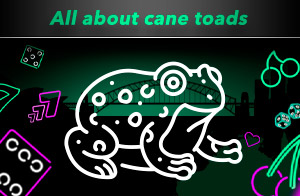and we're not sure what to think!
Have you ever found yourself sitting in traffic or waiting for a train, wondering just how big cane toads can grow? No?
Well, whether you're fascinated by these funky-looking amphibians or you'd rather not know anything about them, we guarantee that the recent news out of Queensland, Australia is something you won't want to miss. But first, what exactly is a cane toad?
What are cane toads?
Cane toads are large, semi-aquatic frogs native to South and Central America. They can grow up to 8 inches in length and generally weigh up to 1 kilogram.
They are very unique creatures, having webbed feet and warty skin that comes in shades of green, brown and yellow. Unfortunately for the cane toad, they're not winning any beauty awards. In fact, if there was a cane toad beauty pageant, we're sure there would be zero supporters in the crowd.
On the plus side, cane toads are extremely tough. They can survive in almost any environment, from deserts to rainforests. And they are also very adaptable with the ability to rapidly adjust to new surroundings.
What is their history in Australia?
Cane toads were first introduced to Australia in 1935 when they were brought over as a way of controlling agricultural pests such as sugar cane beetles.
At the time, sugar cane beetles were a major problem for the Australian sugar cane industry. They were eating away at the crops and causing huge losses for farmers. Consequently, the Australian sugar cane industry lost profits and many people were out of work.
The cane toads were supposed to be a miraculous solution - they would eat the sugar cane beetles and save the industry. Hoorah for cane toads and hoorah for introducing new animals into a delicate environment like Australia!
Things are going to be alright after all...
Why are they considered a pest in Australia?
But (surprise, surprise) it didn't go to plan.
What was thought to be the perfect solution to the cane beetle problem and an economic boon for the sugar cane industry turned out to be a huge disaster.
The cane toads fast became pests themselves, as they had no natural predators in Australia, and their population exploded. They also wreaked havoc on the native wildlife, eating critically endangered species like quolls and goannas.
Sadly, many animals and insects have gone extinct due to the introduction of cane toads.
Of course, we should feel slightly bad for these lumpy-skinned critters. They didn't choose to be relocated to Australia and given the job of chief beetle eater in Queensland. But as so often happens when humans try to tinker with the natural order of things, the introduction of cane toads has been an abject failure.
What is "Toadzilla" and why should I care?
This brings us to a recent announcement in the Australian press that the biggest cane toad ever recorded has just been found in northeast Queensland. Dubbed "Toadzilla", this 2.7-kilogram whopper is a whopping 40 centimetres long.
That's almost twice the size of a typical cane toad!
Now, I know what you're thinking. Why would anyone make a big deal about finding an oversized amphibian?
Well, that's exactly why Toadzilla is so important – it's not just some random giant toad. It's an example of nature turning up the heat on human activities. In Australia and elsewhere, humans have been introducing invasive species into ecosystems which then go on to cause environmental havoc. Unfortunately, cane toads are no exception.
The good news is that Toadzilla may help us understand how best to manage these problem populations before they become even more destructive. And while we won't be able to save every single animal, it's important to remember that we can always make a difference.
So go ahead and give Toadzilla a pat on its slimy back for representing the importance of conservation!
Can humans and cane toads in Australia learn to coexist?
In saying all this, it appears that cane toads are here to stay. And according to experts, 100% eradication is impossible without jeopardising the health of many other animals.
Baiting and trapping have already been used. And to spray poisons into the environment with little to no regard for other animals is irresponsible and downright dangerous. It seems that if we're to get along with our slimy new neighbours, it's time to think of more creative solutions.
That said, there are many organisations and groups that have been trying out various methods for dealing with cane toads. From using fenced enclosures to contain them to encouraging local predators to eat them, progress is being made.
So if you're living in Queensland or any other part of Australia where cane toads have made themselves comfy, don't despair. When we look at the odds, you most likely won't need to worry about stepping off your back deck and onto the next Toadzilla.
The only thing you should worry about is missing the best bonuses, free spin prizes and new games that Uptown Pokies has to offer! No cane toads here – just solid pokies and casino games for you to enjoy!
Gobble down an Uptown Pokies bonus today
Deposit $30+
Get 111% Match Bonus + 111 Spins on Top!
Redeem Coupon: CANETOADS111
Promo info:
CANETOADS111 bonus holds 25x roll over + 5x on spins winnings, available from the 14th of February to the 15th of March, redeemable 2x. Free spins game: Frog Fortunes
